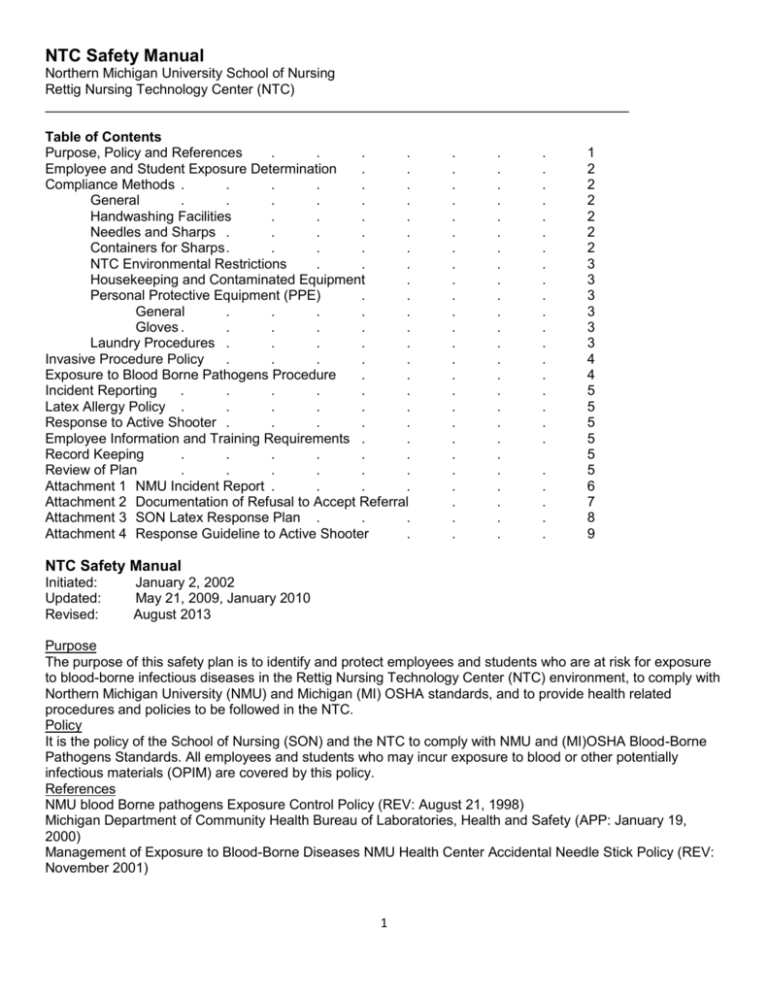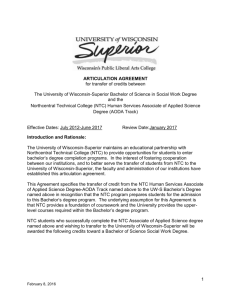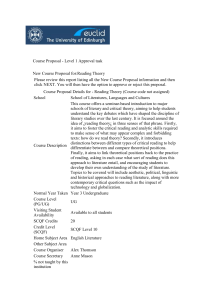NTC Safety Manual - Northern Michigan University
advertisement

NTC Safety Manual Northern Michigan University School of Nursing Rettig Nursing Technology Center (NTC) ____________________________________________________________________________ Table of Contents Purpose, Policy and References . . . . Employee and Student Exposure Determination . . Compliance Methods . . . . . . General . . . . . . Handwashing Facilities . . . . Needles and Sharps . . . . . Containers for Sharps . . . . . NTC Environmental Restrictions . . . Housekeeping and Contaminated Equipment . Personal Protective Equipment (PPE) . . General . . . . . Gloves . . . . . . Laundry Procedures . . . . . Invasive Procedure Policy . . . . . Exposure to Blood Borne Pathogens Procedure . . Incident Reporting . . . . . . Latex Allergy Policy . . . . . . Response to Active Shooter . . . . . Employee Information and Training Requirements . . Record Keeping . . . . . . Review of Plan . . . . . . Attachment 1 NMU Incident Report . . . . Attachment 2 Documentation of Refusal to Accept Referral Attachment 3 SON Latex Response Plan . . . Attachment 4 Response Guideline to Active Shooter . . . . . . . . . . . . . . . . . . . . . . . . . . . . . . . . . . . . . . . . . . . . . . . . . . . . . . . . . . . . . . . . . . . . . . . . . . . 1 2 2 2 2 2 2 3 3 3 3 3 3 4 4 5 5 5 5 5 5 6 7 8 9 NTC Safety Manual Initiated: Updated: Revised: January 2, 2002 May 21, 2009, January 2010 August 2013 Purpose The purpose of this safety plan is to identify and protect employees and students who are at risk for exposure to blood-borne infectious diseases in the Rettig Nursing Technology Center (NTC) environment, to comply with Northern Michigan University (NMU) and Michigan (MI) OSHA standards, and to provide health related procedures and policies to be followed in the NTC. Policy It is the policy of the School of Nursing (SON) and the NTC to comply with NMU and (MI)OSHA Blood-Borne Pathogens Standards. All employees and students who may incur exposure to blood or other potentially infectious materials (OPIM) are covered by this policy. References NMU blood Borne pathogens Exposure Control Policy (REV: August 21, 1998) Michigan Department of Community Health Bureau of Laboratories, Health and Safety (APP: January 19, 2000) Management of Exposure to Blood-Borne Diseases NMU Health Center Accidental Needle Stick Policy (REV: November 2001) 1 Employee and Student Exposure Determination for School of Nursing Job Classification Tasks/Procedures Associate Dean/Director All listed job classifications names: Nursing Support & Simulation Specialist Handling of sharps Faculty Simulation Specialist Handling of sharps containers Professors Collecting and boxing sharps Associate Professors containers for biohazard pickup Adjunct Faculty Managing soiled linens Overload Faculty Performing invasive procedures AAUP Faculty Graduate Assistants NTC Supervisor NTC Clerks, SLAs, & Techs NTC Bulk Stores Assistant Student Nurses Compliance Methods Universal Precautions will be observed in all NTC learning labs to prevent contact with blood or OPIM. All blood and all other human bodily fluids will be considered infectious regardless of the perceived status of the source individual. The following work practices will be utilized to eliminate or minimize exposure. Should risk of exposure remain after institution of these controls, PPE shall also be utilized. 1. HAND WASHING FACILITIES-are readily accessible to those who incur exposure. The NTC Supervisor is responsible for ensuring maintenance and accessibility of all related hand washing equipment and items. 2. NEEDLES AND SHARPS-Uncontaminated or contaminated needles and other sharps will not be bent, recapped, removed, sheared or purposely broken. a. Needles and Sharps: i. Disposable needles and sharps are placed into appropriate sharps containers that are puncture resistant, closeable, leak proof, red, and have a red biohazard label. ii. Sharps are not to be passed from hand to hand. iii. Mechanical recapping devices or one-handed techniques may be used in some situations, however two-handed recapping and using the mouth to hold the cap are strictly forbidden. 3. CONTAINERS FOR SHARPS-will be located in all NTC lab areas where sharps and needles are used. a. Containers must be closeable, puncture resistant, leak proof on sides and bottom, and are red and have red biohazard labels applied to them. b. Containers will be easily accessible and as close as feasible to immediate area where sharps and needles are used. c. Containers are not to overflow, are to be maintained in the upright position, be kept closed and routinely replaced. d. Location for Sharps Containers: i. WS 1609 A & B- one container mounted in each exam room. ii. WS 1613, 1615, 1702, 1704- one container mounted at each bedside. iii. WS 1617- storage room for empty containers, partially filled containers and biohazard collection box for full containers. iv. WS 1532- one container mounted on wall by birthing bed. v. WS 1534- one container mounted on wall by ICU bed. vi. WS 1701, 1703, 3618- containers provided in rooms as needed. e. Sharps containers will not be opened, emptied or cleaned manually. 2 f. If the sharps container has been contaminated on the outside, with donned gloves, it must be put in a biohazard bag and placed into a biohazard collection box. g. Responsible persons for collecting and boxing containers: NTC Supervisor and NTC Clerks. 4. NTC ENVIRONMENTAL RESTRICTIONS: In areas where there is a possibility of exposure to blood or OPIM it is not permitted to eat, drink, apply cosmetics or lip balm or handle contact lenses. 5. HOUSEKEEPING AND CONTAINED EQUIPMENT: Equipment that has become contaminated with blood or OPIM shall be examined prior to prepping for pickup and shall be decontaminated as necessary: a. All equipment and environmental and working surfaces shall be cleaned and decontaminated if contact with blood or OPIM using a solution of 1 part bleach to 8 parts water. Decontamination shall be done immediately after the procedure or as soon as feasible after any spill of blood or OPIM. b. Broken glass will not be picked up directly with the hands. A broom and dust pan must be used, located in WS1611, and the materials placed in a puncture proof container. Vacuum cleaners are not to be used to pick up broken glass. c. Tools used to clean up must be decontaminated or properly disposed of after use. 6. PERSONAL PROTECTION EQUIPMENT (PPE): General: PPE will be provided by the NTC without cost. PPE will be chosen based on anticipated exposure to blood or OPIM. PPE is considered appropriate if it does not permit blood or OPIM to pass through or reach clothing, skin, eyes, mouth or other mucus membranes under normal conditions of use and for the duration of the time in which the PPE will be used. All garments, which are penetrated by blood, shall be removed immediately or as soon as possible and placed in appropriate receptacles. All PPE will be removed before leaving NTC lab rooms. Gloves: Gloves will be used when it is reasonably anticipated that hand contact will be made with blood or OPIM, mucus membranes or non-intact skin or when handling or touching contaminated surfaces or items. Gloves must be worn for the following procedures: o Oral care o Administering blood glucose checks o Administering TB skin tests Disposable gloves will not be re-used, washed or decontaminated. Disposable gloves will be replaced when their ability to function as a barrier has been compromised, or if they become contaminated. Hypoallergenic gloves, powderless gloves or other similar alternatives will be provided to those allergic to gloves normally provided. Handwashing after glove removal is required. Studies have shown that although gloves provide a barrier they are not completely impermeable. Utility gloves may be decontaminated for re-use if the integrity of the glove is not compromised. Utility gloves will be discarded if they are cracked, peeling, torn, punctured or if ability to function is compromised. 7. LAUNDRY PROCEDURES: a. Laundry contaminated with blood or OPIM will be handled as little as possible. Such laundry will not be sorted or rinsed in the area of use. b. Gloves are to be worn to place contaminated laundry in the clear plastic and red labeled biohazard laundry bags. c. Home laundering is not permitted. d. College Laundry and Rentals is the vendor used for laundry services. This agency uses universal precautions. 3 Invasive Procedure Policy in the NTC 1. No student shall perform an invasive procedure on another student or volunteer. 2. Invasive procedures are any nursing procedure that involves entry into any body cavity and/or invades the integrity of the skin or body cavity, unless identified as an exception to this policy. 3. Only mannequins or other instructional aides shall be used for such practice. 4. Exceptions to the policy include the following procedures: a. Oral and ear assessments b. Oral and tympanic temperatures c. Oral feeding d. Nasal exams e. Vaginal exams f. TB skin test administration with supervision g. Glucose checks with supervision Exposure to Blood-Borne Pathogens Procedure for Management of Accidental Exposure to Blood-Borne Diseases 1. Significant exposure is defined as percutaneous, ocular, or mucous membrane exposure to blood or other body fluids containing visible blood. 2. If possible, the wound or exposed area shall be immediately and thoroughly washed with soap and water, or irrigated with tap water for eyes or other mucous membrane. 3. A NMU Incident Report for Accident/Injury/Illness shall be completed and returned to the NTC Supervisor. Incident Report forms are in a hanging file located at the NTC Clerk’s desk. (For online link see Attachment 1). 4. The Exposed Person will be referred to the NMU Health Center. A physician’s visit is not needed, but a scheduled nurse visit and lab draws must be done on the same day as the incident. 5. The nurse will administer Tetanus toxoid 0.5ml IM if no Tetanus booster within 10 years. 6. If the Exposed Person has not received Hepatitis B vaccine, the initial immunization will be offered. For greatest effectiveness, Hepatitis B immune globulin (HBIG) should be given as soon as possible after exposure, preferably within 24 hours. Its value beyond seven days after exposure is unclear. The dose is 0.06ml/kg, to a maximum of 5ml, IM. BILLING: The patient will be responsible for this charge. 7. The Exposed Person will have the following labs drawn: a. Rapid HIV antibody b. HCV c. ALT (SGPT) d. Hepatitis B surface antibody (HBsAB) e. Hepatitis B surface antigen (HBsAg) f. BILLING: The Exposed Person’s bill is submitted to the patient’s health insurance first, then to the department where the incident occurred. At no time should anyone be denied testing. 8. REFUSAL OF TREATMENTa. If the Exposed Person refuses to accept referral to the Health Center a Documentation of Refusal to Accept Referral form shall be completed and returned to the NTC Supervisor (Attachment 2). b. The NMU Health Center is to be notified of the Exposed Person’s refusal to accept referral. c. If the Exposed Person accepts referral but does not give consent for HIV testing the Health Center will draw an extra tube and tell the patient is will be saved for 90 days. They can elect to have testing up to that time. Otherwise the sample will be discarded. 9. If the SOURCE PATIENT is identifiable, they shall be informed of the incident and requested to report to the Health Center to have the following labs drawn: a. HIV antibody b. Hepatitis B surface antigen – unless patient has had 3 Hepatitis B shots, then a Hepatitis BsAB test will be done instead. c. HCV 4 d. BILLING: The cost will be paid by the Health Center as incentive for the source patient to be tested. 10. If any tests are positive, the physician will make recommendations for prophylaxis based on the latest available guidelines. 11. The physician may advise the Exposed Person to return for additional HIV testing depending upon the nature of the exposure. 12. NTC Supervisor is responsible for assuring SON required paperwork is completed regarding exposure in the NTC. Incident Reporting Any accident or incident occurring in the NTC shall be reported immediately to supervising faculty and NTC Supervisor. An NMU Incident Report form is to be filled out and submitted per NMU protocol. (Attachment 1) Latex Allergy Management Students who have been identified as having a latex allergy/sensitivity or have been medically advised to avoid latex should coordinate with each clinical instructor and the NTC Supervisor to plan for his/her safety. It is incumbent for the student to monitor their environment for possible risk of exposure. Student may request latex allergy carts at clinical sites. 1. For management of known allergies and procedure for exposure see Nursing Latex Response Plan (Attachment 3). Response to Active Shooter In the event of an ACTIVE SHOOTER on campus: 1. Refer to Response Guidelines for an Active Shooter (Attachment 4). Employee Information and Training Requirements 1. All NTC employees will be trained prior to initial assignment to NTC exposure and safety policies and procedures. 2. NTC Supervisor will schedule and keep record of NTC staff safety training. 3. NTC Supervisor will be responsible for refresher training as needed. Record Keeping 1. The NTC Supervisor will maintain and update the following nursing student records: a. MMR – (for Rubella record) b. Tetanus – (within 10 years) c. Hepatitis B d. TB skin test results e. TB Questionnaires and/or chest x-ray results f. CPR g. Flu Shot h. Criminal Background Checks 2. Incident reports will be maintained by the NTC Supervisor. Review of Plan This plan will be reviewed and updated by the NTC Supervisor and approved by the SON Safety Committee. Initiated: 1/02; Rev. 5/09, 1/10, 5/13 5 Attachment 1 NMU Incident Report for Accident/Injury/Illness Forms 1. NMU Public Safety Link for Incident Reporting. Options of online PDF Format for completion of current form and sending via email or for Microsoft Word Format for printing copies and filling out with pen. http://www.nmu.edu/publicsafety/node/7 Initiated: Spring 2008, Rev. May 2009, Rev. January 2010, Rev. 5/2013 6 Attachment 2 Northern Michigan University School of Nursing Rettig Nursing Technology Center Documentation of Refusal to Accept Referral Date: _____________________________________ Date of Birth: _______________________ Name: ______________________________________________________________________ Address: ____________________________________________________________________ Reason for Referral: ___________________________________________________________ ____________________________________________________________________________ ____________________________________________________________________________ ____________________________________________________________________________ I have been advised to go to the NMU Health Center or affiliate employee health services immediately for counseling and testing because of the above-mentioned reason(s). Even though it has been recommended that I do so, I do not plan to go now for the following reason(s): ____________________________________________________________________________ ___________________________________________________________________________ ____________________________________________________________________________ ____________________________________________________________________________ ____________________________________________________________________________ The following possible risks of not accepting or acting upon the referral have been explained to me: ___________________________________________________________________________ ____________________________________________________________________________ ____________________________________________________________________________ ____________________________________________________________________________ I hereby release Northern Michigan University and NMU School of Nursing from any and all liability arising out of or connected with my decision not to follow the above medical recommendation. Signature: ____________________________________ Date: __________________________ I witness the fact that the individual signed the above and said he/she read and understood the same. Witness Signature: ____________________________________ Date: ___________________ c: NMU Health Center Initiated: January 2002, Rev. May 2009 7 Attachment 3 School of Nursing Latex Response Plan When working in the clinical setting or nursing skills labs, students may be exposed to latex and other allergens. Procedure: For students with known sensitivity/allergy to latex or any other element in the skills lab or clinical environment, it is recommended that you: Obtain consultation from your health care provider about your sensitivity/allergy, risks and treatment. Inform the NTC Supervisor, skills lab faculty and your clinical instructor of your sensitivity. o Latex-free gloves can be provided. However, the lab environment and clinical facilities are not latex free. Inform the faculty member of your plan to handle a reaction. In case of a life-threatening reaction in a nursing clinic or skills lab, an ambulance is to be summoned. Any faculty member or student may dial 911 on the phone. State that you have a life threatening “Latex emergency” and need an ambulance. Epinephrine will be needed. Do not handle the victim with any latex products. Victim will be transferred to a hospital in the community by ambulance. It is helpful for the ambulance personnel to know the victim’s allergies, current medications and any medical conditions. If a student or faculty member has a reaction requiring medical attention, a SON Incident Report is to be completed and forwarded to the NTC Supervisor. I have reviewed the above policy and understand that questions regarding this policy are to be directed to the NTC Supervisor. Student/Faculty Signature: __________________________________________________ Printed Name: ___________________________________________________________ Date: ___________________________________________________________________ Initiated: 7/02, Rev. 5/09 8 Attachment 4 Response Guidelines for an Active Shooter Secure Immediate Area Lock and barricade doors Turn off lights Close blinds Block windows Turn off radios and computer monitors Keep occupants calm, quiet, and out of sight Keep yourself out of sight and take adequate cover/protection (i.e. concrete walls, thick desks, filing cabinets), which may protect you from bullets Silence cell phones Place signs in exterior windows to identify the location of injured persons Contacting Authorities Use 911 (dialing 911 from a campus phone will connect you with NMU Public Safety) Dialing 911 from a cell phone will connect with Marquette County Central Dispatch. Make sure to give the dispatcher your exact location Dialing 227-2151 will contact you with central dispatch at NMU Public Safety (the non-emergency line) Be aware that the 911 system will likely be overwhelmed Program the NMU Public Safety and Police Services administrative line (227-2151) into your cell phone for emergency use What to Report: Your specific location, in particular the building name and the office or room number The number of people at your specific location The number of injured persons and what types of injuries have been suffered Provide as much of the following information as is known o Assailant’s location o Number of suspects o Race o Gender o Clothing description o Physical features o Type of weapons (long gun or hand gun) o Backpack type o Shooter’s identity o Type of incident – i.e. shooting or explosion Un-securing an Area Consider risks before un-securing rooms Remember, the shooter will not stop until they are engaged by an outside force Attempts to rescue people should only be made if they can be accomplished without further endangering the persons inside a secured area Consider the safety of masses vs. the safety of a few If doubt exists for the safety of the individuals inside the room, the area should be secured. Initiated: Spring 2008, Rev. 5/2009 9






